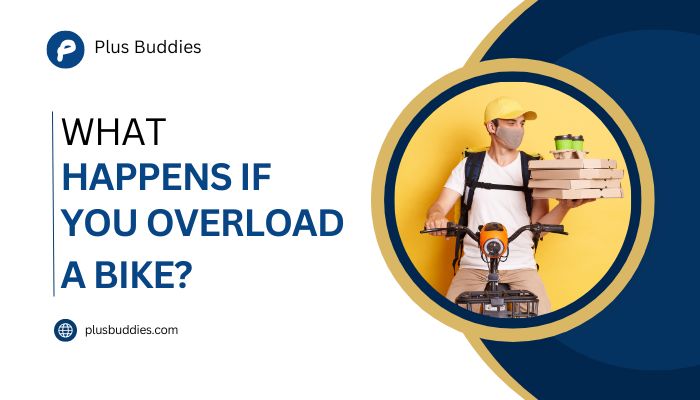Bicycles have been a popular mode of transportation and recreation for centuries. With over 1 billion bicycles estimated to be in use worldwide, they are a symbol of simplicity, eco-friendliness, and physical well-being However, like any other vehicle, bicycles have limitations, and overloading them can lead to various issues. In this article, we’ll delve into what happens when you overload a bike, the potential risks and consequences, and address common questions related to this topic.
The Lowdown on Weight Limits
No matter if you’re rolling on a road, mountain, hybrid, or cruiser bike, each one has its own weight limit. The folks who make these bikes decide this limit based on the materials they’re made of, how they’re built, and what they’re meant to do. Going over these limits? Yeah, it’s a recipe for disaster.
Taking a Toll on Control and Handling
Picture this: you’ve got an overloaded bike. The whole control and handling thing? It goes out the window. The extra weight turns your once-awesome ride into a wobbly mess. Steering gets trickier, balance is a tightrope act, and navigating becomes a wild adventure. Speed up, and things get even scarier, especially on bumpy trails.
Putting the Squeeze on Bike Parts
Every bike part – the frame, wheels, tires, brakes – they’ve got their own superhero strength. But hey, overloading your ride piles on the pressure like nobody’s business. Those trusty parts are taking more than they can chew, leading to wear and tear way before their time. Think bent rims, broken spokes, and brakes that go from heroes to zeros.
What’s Really at Risk? More Accidents, Less Fun
When your bike’s overloaded, control goes on vacation. Quick turns? Emergency stops? Navigating busy streets? All of it gets riskier. Accidents, spills, and banged-up riders – that’s the unfortunate result.
Frame Fiasco
The bike’s backbone – the frame – takes a hit. Too much weight means more stress in the wrong places, leading to cracks or a full-on frame meltdown. A compromised frame? That’s a one-way ticket to an unsafe ride.
Tire and Brake Blues
Tires and brakes aren’t too thrilled with the extra load either. Tires wear out faster, say hello to more flats, and brakes might just decide to take a break. Stopping distances get longer, and suddenly safety takes a back seat.
Speed and Joy Take a Hit
Say goodbye to the joy of pedaling. Overloading slows you down, especially uphill. You’re working extra hard, but the bike’s not having it.
3 Tips to Keep You in the Clear
Know Your Bike’s Crush Point
Check out your bike’s manual or the maker’s website to find the magic number – the weight it can handle. Stick to it like glue, for your sake and your bike’s.
Even Out the Load
When it’s time to carry stuff, use racks or panniers made for your bike. Spreading the weight around means better control and less stress on your bike’s bones.
Give Your Bike Some Love
Regular check-ups are the ticket. Tire pressure? Brakes? All the parts in their happy places? Make sure your bike’s feeling good and strong. It’s a game-changer, especially when you’re hauling extra cargo.
Wrap It Up
So, overloading your bike’s not a game to play. It messes with control, messes up parts, and brings accidents to the party. Stay within those weight limits, share the load, and show your bike some love with regular TLC. By understanding the no-nos of overloading and staying on the safe side, you’ll have a trusty bike for many adventures to come. Time to roll, responsibly!
Frequently Asked Questions
Q. What is the maximum weight a bike can typically handle?
A. The maximum weight a bike can handle varies depending on the bike’s design, materials, and intended use. Generally, most bikes have weight limits ranging from 250 to 300 pounds (113 to 136 kilograms). It’s crucial to consult your bike’s manual or contact the manufacturer to determine the specific weight limit.
Q. Can I carry a heavy load on a bike equipped with a rack or panniers?
While racks and panniers are designed to help distribute weight more evenly, it’s important to stay within the bike’s weight limit even with these accessories. Proper weight distribution can improve stability and handling, but overloading the bike still poses risks.
Q. Can overloading a bike cause long-term damage?
Yes, overloading a bike can lead to long-term damage. Continuous stress on the frame and components can result in premature wear and structural failure. It’s best to respect the manufacturer’s weight recommendations to ensure the bike’s longevity.
Q. Can I increase the weight limit of my bike by upgrading certain components?
While upgrading components like wheels, tires, and brakes can enhance the bike’s overall strength and performance, it’s unlikely to increase the weight limit set by the manufacturer significantly. The frame’s design and material largely determine the weight limit, which cannot be altered through component upgrades.
Q. Is there a difference in weight limits between bike sizes or models from the same manufacturer?
Bike manufacturers typically set weight limits based on a particular model’s overall design and intended usage. While larger frame sizes may have slightly higher weight limits due to the increased material, the difference is often minimal. Always refer to the specific weight limit for your bike model and size.
Q. Are there any guidelines for carrying children on a bike without overloading it?
A. Many bike manufacturers offer child-carrying accessories like child seats and trailers to transport children while maintaining proper weight distribution safely. Follow the manufacturer’s recommendations and weight limits for these accessories to ensure a safe ride for you and your child.

Welcome, I am Jerry Harper. I provide plus-size accessories encompassing swimwear, treadmills, bathing, and shoes. and more. I specialise in crafting innovative concepts that captivate readers within the dynamic landscape of plus-size fashion trends.
